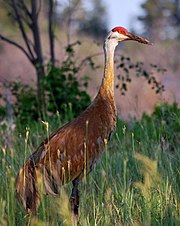Genus of birds
Antigone genus of large birds in the crane family.[ 2] Grus
Taxonomy
The genus was named by Carl Linnaeus to be used for the sarus crane or its old name Grus major Indica because he was confused between Greek princesses Antigone of Troy who turned into a stork and Gerana who turned into the crane.[ 3]
A molecular phylogenetic study published in 2010 found that the genus Grus polyphyletic .[ 4] Antigone .[ 2] Ludwig Reichenbach .[ 5] type species is the sarus crane (Antigone antigone ).[ 6]
Species
The genus includes four species:[ 2]
Genus Antigone Reichenbach , 1853
Common name
Scientific name and subspecies
Range
Size and ecology
IUCN status and estimated population
Sandhill crane
Antigone canadensis (Linnaeus, 1758)
A. c. canadensis (Linnaeus , 1758) – northeast Siberia through Alaska and north Canada to Baffin Island
A. c. tabida (Peters, JL , 1925) – south Canada and west, central United States
A. c. pratensis (Meyer, FAA , 1794) – Georgia and Florida
A. c. pulla (Aldrich , 1972) – Mississippi
A. c. nesiotes (Bangs & Zappey, 1905) – Cuba and Isla de la Juventud (Isle of Pines)
North America and extreme northeastern Siberia
Size : Habitat : Diet :
LC
White-naped crane
Antigone vipio (Pallas, 1811)
Northeastern Mongolia, Northeastern China, and adjacent areas of Southeastern Russia
Size : Habitat : Diet :
VU
Sarus crane
Antigone antigone (Linnaeus, 1758)
A. a. antigone (Linnaeus, 1758) (Indian sarus crane)
A. a. sharpii Blanford, 1895 (Indochinese or Burmese sarus crane, Sharpe's crane, red-headed crane)
A. a. gilliae Schodde, 1988 (Australian sarus crane)
A. a. luzonica Hachisuka , 1941 (Philippine sarus crane – extinct ) Indian subcontinent, Southeast Asia, and Australia
Size : Habitat : Diet :
VU
Brolga
Antigone rubicunda (Perry, 1810)
Northern and eastern Australia and New Guinea
Size : Habitat : Diet :
LC
References
^ "Gruidae" . aviansystematics.org . The Trust for Avian Systematics. Retrieved 2023-07-27 .^ a b c Gill, Frank ; Donsker, David, eds. (2019). "Flufftails, finfoots, rails, trumpeters, cranes, limpkin" . World Bird List Version 9.2 . International Ornithologists' Union. Retrieved 26 June 2019 .^ Jobling, James A. (2010). Helm Dictionary of Scientific Bird Names . London, UK: Christopher Helm . pp. 49–50. ISBN 978-1-4081-3326-2 OCLC 659731768 . ^ Krajewski, C.; Sipiorski, J.T.; Anderson, F.E. (2010). "Mitochondrial genome sequences and the phylogeny of cranes (Gruiformes: Gruidae)" . Auk . 127 (2): 440–452. doi :10.1525/auk.2009.09045 S2CID 85412892 . ^ Reichenbach, Ludwig (1853). Handbuch der speciellen Ornithologie ^ Dickinson, E.C. ; Remsen, J.V. Jr. , eds. (2013). The Howard & Moore Complete Checklist of the Birds of the World . Vol. 1: Non-passerines (4th ed.). Eastbourne, UK: Aves Press. p. 164. ISBN 978-0-9568611-0-8
External links
Antigone Antigone
Balearicinae
Gruinae








